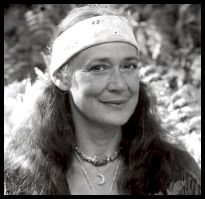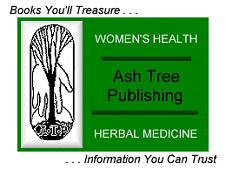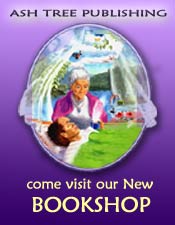The use of psychoactive plants is a the cornerstone
of herbal wisdom in every indigenous culture I have had the
opportunity to visit or read about. (1) Harvard professor
Richard Evans Schultes says of the principal shaman of the
Kamsa Indians of the Amazon, where psychoactive plants are
widely used: "He insists that his knowledge and power
come to him directly from the plants themselves through hallucinations."(2)
Modern America demonizes and legislates against
psychoactive plants and their users. If we agree, and therefore
back off from using these plants, we deny ourselves one of
the most important links between people and plants -- a link
that dates back at least 40,000 years. (3)
The psychoactive link between people and plants
is not limited to actual ingestion of the psychoactive plants.
Teachers like David Winston, Isla Burgess (4), Stephen Buhner
(5), and myself make a regular practice of not only talking
with the plants, but also teaching others how to do so. But
this, to my mind, it is rather like learning to play music
when your ears are stoppled. Psychoactive plants open our
inner ears, and help us hear the language and music of the
plants.
Psychoactive plants reveal healing information
about themselves, other plants and people, too. Maria Sabina,
Mazatec shaman, said that psilocybin mushrooms opened "The
Book of Wisdom, The Sacred Book of Language" for
her so she might know how to heal each person. (6)
Psychoactive plants are direct healers of troubled
minds when used wisely. I hope that we can, at least among
ourselves, acknowledge the tremendous healing powers -- for
both person and planet -- of psychoactive plants. Perhaps
it would help if we think of them not as hallucinogens but
as "realitons": plants that can show us REALITY,
if we know where and how to look. The Huichol of Mexico say
they smoke psychoactive leaves "to produce clearer visions."
Where to look? Within, and in Nature. How to
look? By honoring the power plant, by honoring yourself, and
by creating a safe set and setting. Rituals provides extra
safety.
In addition to the usual power plants, you may
wish to try some of these:
Amanita muscaria (fly agaric mushroom/soma) ~ 1 fresh cap eaten; dried/smoked (inferior) "This mushroom [is] perhaps man's oldest hallucinogen. . . ." (POG/Plants of the Gods)
Artemisia vulgaris (cronewort/moxa) ~ dried leaves (and blossoms) smoked
Coleus blumei (painted nettle) ~ 20-30 fresh leaves chewed, no swallowed; dried/smoked (8) (POG)
Cymbopogon densiflorus (lemongrass) ~ dried flowers smoked (POG)
Lactuca verosa (wild lettuce) ~ sap collected, dried and smoked
Leonotus leonurus (dagga) ~ dried leaves smoked (POG)
Lobelia inflata (puke weed) ~ 1/2 - 1 fresh leaves eaten (a favorite of mine)
Phragmites australis (common reed) ~ rootstock, with caution; best fermented (POG)
Phytolacca americana (poke) ~ 1-4 ripe berries, fresh or dried; 5-25 drops root tincture
Piper methysticum (kava kava/intoxicating pepper) ~ fresh or dried root infusion; ferment (8)
Salvia divinorum (diviner's sage) ~ dried leaves smoked
Solanum nigra (black nightshade) ~ 1-2 unripe fruits
Solanum dulce-mare (bittersweet nightshade) ~ 1-2 unripe fruits
Tagetes lucida (yauhtli) ~ dried leaves (and blossoms?) smoked (POG)
Appendix 1 Worldwide Association
of Shamanic Herbalists and Healers (WASHAH)
WASHAH is an invisible association. There are
no board meetings, no dues, no membership drive, no fund raising.
WASHAH is a figment of our imaginations. As such, it is always
changing.
The purpose of WASHAH is to make visible the shamanic healer
and to declare in clear terms the impossibility and absurdity
licensing shamanic healers. Let us present ourselves to ourselves,
each other, and our communities--as we have always done, through
story, song, dance, and drama, and now through defining words--so
that the weave of everyone's reality is touched by a shamanic
thread, and our work is kept safe from restriction by the
language of law.

What are the characteristics of the shamanic
healer? What ought a shamanic healer not do? Here's my beginning
list of the characteristics of shamanic healers/herbalists.
Please change and transform as you will, as you wish, in person,
on the Web, and in dreamtime.
1 * Shamanic healers and herbalists answer to
universal law; they do not need permission from, nor to be
licensed by, man's law.
2 * Shamanic healers and herbalists work without
regard for payment, but absolutely insist on being honored
for and supported in the work they do.
3 * Shamanic healers and herbalists use local
herbs, harvested in ways that sustain or build plant populations.
They talk/pray with the plants and accord them power, dignity,
and sentience.
4 * Shamanic healers and herbalists use psychoactive
plants as healing allies. They frequently keep a personal
supply on hand, plus enough for apprentices. Restrictions
on the use of these plants unfairly prevents shamanic herbalists/healers
from accessing needed information.
5 * As shamanic healers and herbalists may be
very limited in their ability to read and write; written tests
are of little or no use is determining their knowledge, wisdom,
or worth.
6 * Shamanic healers may be quite limited in
their understanding of Western anatomy, physiology, and chemistry.
Nonetheless, each shamanic healer has a "story"
about the nature of the world(s) s/he inhabits, and a vision
of the health/wholeness toward which individual patients are
moving.
7 * Shamanic healers use drama and ceremony;
whether public or private, a shamanic healing is rhythmic,
colorful, memorable, and suffused with the unexpected, unique
gifts of the moment.
8 * Shamanic healers use the power of kundalini/life
force. They may be raunchy, suggestive, and lewd. They generally
do not engage in genital sex with their patients/clients,
however, nor do they imply or state that their healing help
can be best accessed through sexual connection.
Resources
1. This reference has been removed by request of the reference
herself for the sake of privacy.
2. Richard Evens Schultes, Robert F. Raffauf. Vine of
the Soul. 1992, Synergetic Press.
3. DNA tests strongly suggest that humans began to change
or "cultivate" psychoactive plants about 40,000
years ago. The earliest validated date for cultivation of
food plants is 10,000 years. Is it four times more important
to us to dependably fill our minds than to dependably fill
our bellies?
4. Isla Burgess. Weeds Heal, A Working Herbal. 1998,
Veriditas Publishing.
5. Stephen Buhner. Lost Language of Plants: The Ecological
Importance of Plant Medicine to Life on Earth. 2001,
6. Alvaro Estrada. Maria Sabina, Her Life and Chants.
1981, Ross-Erickson.
7. Schultes, Hoffman & Ratsch. Plants of the Gods.
1998, Healing Arts Press.
8. Ray Thorpe. Happy High Herbs. 2001, Possibility.com
9. Chris Kilham. Psychedilicacies. 2001, Rodale.

 Study
with Susun Weed in the convenience of your home! Choose from
three Correspondence
Courses: Green Allies, Spirit & Practice of the Wise
Woman Tradition, and Green Witch - includes audio/video tapes,
books, assignments, special mailings, plus personal time.
Study
with Susun Weed in the convenience of your home! Choose from
three Correspondence
Courses: Green Allies, Spirit & Practice of the Wise
Woman Tradition, and Green Witch - includes audio/video tapes,
books, assignments, special mailings, plus personal time.
Learn more at www.susunweed.com
or write to:
Susun Weed
PO Box 64
Woodstock, NY 12498
Visit Susun Weed at: www.susunweed.com
and www.wisewomanbookshop.com
For permission to reprint this article, contact us at: www.wisewomanbookshop.com
Vibrant, passionate, and involved, Susun Weed has garnered
an international reputation for her groundbreaking lectures,
teachings, and writings on health and nutrition. She challenges
conventional medical approaches with humor, insight, and her
vast encyclopedic knowledge of herbal medicine. Unabashedly
pro-woman, her animated and enthusiastic lectures are engaging
and often profoundly provocative.
Susun is one of America's best-known authorities on herbal
medicine and natural approaches to women's health. Her four
best-selling books are recommended by expert herbalists and
well-known physicians and are used and cherished by millions
of women around the world. Learn more at www.susunweed.com


 Study
with Susun Weed in the convenience of your home! Choose from
three
Study
with Susun Weed in the convenience of your home! Choose from
three 

